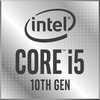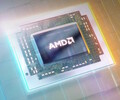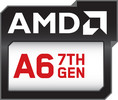Intel Core i5-1035G7 vs AMD A9-9420 vs AMD A6-9220e
Intel Core i5-1035G7
► remove from comparison
The Intel Core i5-1035G7 is a power efficient quad-core SoC for laptops and Ultrabooks based on the Ice -Lake-U generation that was announced in Mai 2019 (Computex). It integrates four Sunnycove processor cores (8 threads thanks to HyperThreading) clocked at 1.2 (base) - 3.7 (single core Turbo) GHz. 2 cores can reach 3.6 GHz and all four 3.3 GHz using Turbo Boost. According to Intel the Sunnycove cores achieve 18% more IPCs (Instructions per Clock). The Core i5-1035G7 is the second fastest Ice Lake-U chip at the time of announcement in 2019.
The biggest improvement for Ice-Lake is the integrated Gen 11 graphics adapter called Iris Plus Graphics. The Core i7-1065G7 integrates the biggest G7 variant with 64 CUs clocked at 300 - 1100 MHz. The Iris Plus G7 should be twice as fast as the predecessors and best the AMD Vega 10 GPU in current Ryzen APUs.
Other improvements for Ice Lake are the AI hardware acceleration and the partial integration of Thunderbolt and Wifi 6 in the chip. The integrated DDR4 memory controller supports modules with up to 3200 MHz (and LPDDDR4-3733).
Performance
The average 1035G7 in our database is in the same league as the Ryzen 3 4300U and the Core i5-10210U, as far as multi-thread benchmark scores are concerned. Which isn't bad at all as of late 2021. The Core i5-1035G4 and the Core i5-1035G1 are two other chips that nearly match the 1035G7 in multi-thread performance.
Thanks to its decent cooling solution and a long-term CPU power limit of 22 W, the Surface Laptop 3 13 is among the fastest laptops built around the 1035G7 that we know of. It can be at least 30% faster in CPU-bound workloads than the slowest system featuring the same chip in our database, as of August 2023.
Power consumption
This Core i5 has a default TDP (also known as the long-term power limit) of 15 W, a value that laptop manufacturers are allowed to change to anything between 12 W and 25 W if required with clock speeds and performance changing accordingly. Those values are a little too high to allow for passively cooled designs.
The processor is built with Intel's second-gen 10 nm process for decent, as of late 2022, energy efficiency.
AMD A9-9420
► remove from comparison
The AMD A9-9420 is an entry-level chip from the Stoney-Ridge APU series for notebooks (7th APU generation), which was announced mid 2016. At its launch, the A9-9420 is the fastest Stoney Ridge processor (dual-core version of Bristol Ridge) and takes over that place from the A9-9410 (-100 MHz CPU clock). It integrates two CPU cores (one Excavator module with 2 integer and on FP unit) clocked between 3 - 3.6 GHz. It also includes a Radeon R5 GPU with 192 shaders at 800 MHz as well as a single-channel DDR4-2133 memory controller, H.265 video engine and chipset with all I/O ports.
Architecture
Stoney Ridge is the successor of the Carrizo architecture and the design is almost identical. Thanks to optimized manufacturing processes and more aggressive Boost behavior, however, the clocks are a bit higher at the same power consumption. The memory controller now also supports DDR4-RAM, in this case up to 2133 MHz. Stoney Ridge is the designation for the smaller dual-core and single-core chip, while Bristol Ridge is the bigger quad-core chip with dual-channel memory controller. More technical details are available in the following articles:
Performance
Thanks to the high maximum clock of up to 3.6 GHz, the single-core performance should be pretty good. The multi-core performance on the other hand is much lower compared to the Bristol Ridge models. Compared to older Carrizo-L/Beema quad-cores, the APU should still perform pretty well. The level of performance should be similar to a Core-m3 and therefore also be sufficient for more demanding applications.
The TDP can be configured between 10-25 Watts, so there can be big performance differences under sustained workloads.
Graphics Card
The integrated Radeon R5 (Stoney Ridge) GPU has 192 active shader units (3 compute cores) clocked at up to 800 MHz. More details about the GPU are available in the linked articles above.
Power Consumption
AMD specifies the TDP of the A9-9420 with 15 Watts, but it can be configured between 10-25 Watts. This means the CPU is a good choice for thin and light notebooks, but also 15-inch devices with better cooling capabilities.
AMD A6-9220e
► remove from comparison
The AMD A6-9220e is an entry-level chip from the Stoney-Ridge APU series for notebooks (7th APU generation), which was announced mid 2017. The 9220e is an entry-level Stoney Ridge processor (dual-core version of Bristol Ridge) and integrates two CPU cores (one Excavator module with 2 integer and on FP unit) clocked between 1.6 - 2.4 GHz. It also includes a Radeon R4 GPU, probably with 192 shaders at 600 MHz, as well as a single-channel DDR4-2133 memory controller, H.265 video engine and chipset with all I/O ports. Compared to the similar named A6-9220 the 9220e is significantly slower clocked (2.5 - 2.9 GHz) including the GPU (600 versus 655 MHz) and can be passively cooled thanks to the TDP of 6W.
Architecture
Stoney Ridge is the successor of the Carrizo architecture and the design is almost identical. Thanks to optimized manufacturing processes and more aggressive Boost behavior, however, the clocks are a bit higher at the same power consumption. The memory controller now also supports DDR4-RAM, in this case up to 2133 MHz. Stoney Ridge is the designation for the smaller dual-core and single-core chip, while Bristol Ridge is the bigger quad-core chip with dual-channel memory controller. More technical details are available in the following articles:
Performance
Because of the significantly lower clock speed, the A6-9220e is noticeably slower than the A6-9220. In the Cinebench R15 Multi benchmark the 9220 reaches 38% higher scores, in the single thread test its more than twice as fast (219% versus the 9220 in the HP 255 G6). Compared to Intel CPUs, the A6-9220e is on par with the old Celeron N2820 in Cinebench (single and multi core). Therefore, the CPU is placed in the lowest segment (performance wise) and only suited for light tasks and light multitasking.
Graphics Card
The integrated Radeon R4 (Stoney Ridge) GPU is probably similar to the R5 with 192 active shader units (3 compute cores), but a reduced clock of just 655 instead of 800 MHz. More details about the GPU are available in the linked articles above.
Power Consumption
AMD specifies the TDP of the A6-9220e with 6 Watts and therefore significantly below the 15 W of the A6-9220. This means the APU can be passively cooled and is a good choice for thin and light notebooks.
| Model | Intel Core i5-1035G7 | AMD A9-9420 | AMD A6-9220e | ||||||||||||||||||||||||||||||||||||||||||||||||||||||||||||||||||||||||||||||||||||||||||||||||||||||||||||||||||||||||||||||||
| Series | Intel Ice Lake | AMD Bristol Ridge | AMD Bristol Ridge | ||||||||||||||||||||||||||||||||||||||||||||||||||||||||||||||||||||||||||||||||||||||||||||||||||||||||||||||||||||||||||||||||
| Codename | Ice Lake-U | Stoney Ridge | Stoney Ridge | ||||||||||||||||||||||||||||||||||||||||||||||||||||||||||||||||||||||||||||||||||||||||||||||||||||||||||||||||||||||||||||||||
| Series: Bristol Ridge Stoney Ridge |
|
|
| ||||||||||||||||||||||||||||||||||||||||||||||||||||||||||||||||||||||||||||||||||||||||||||||||||||||||||||||||||||||||||||||||
| Clock | 1200 - 3700 MHz | 3000 - 3600 MHz | 1600 - 2400 MHz | ||||||||||||||||||||||||||||||||||||||||||||||||||||||||||||||||||||||||||||||||||||||||||||||||||||||||||||||||||||||||||||||||
| L1 Cache | 192 KB | 160 KB | |||||||||||||||||||||||||||||||||||||||||||||||||||||||||||||||||||||||||||||||||||||||||||||||||||||||||||||||||||||||||||||||||
| L2 Cache | 2 MB | 1 MB | 1 MB | ||||||||||||||||||||||||||||||||||||||||||||||||||||||||||||||||||||||||||||||||||||||||||||||||||||||||||||||||||||||||||||||||
| L3 Cache | 6 MB | ||||||||||||||||||||||||||||||||||||||||||||||||||||||||||||||||||||||||||||||||||||||||||||||||||||||||||||||||||||||||||||||||||
| Cores / Threads | 4 / 8 | 2 / 2 | 2 / 2 | ||||||||||||||||||||||||||||||||||||||||||||||||||||||||||||||||||||||||||||||||||||||||||||||||||||||||||||||||||||||||||||||||
| TDP | 15 Watt | 10-25 Watt | 6 Watt | ||||||||||||||||||||||||||||||||||||||||||||||||||||||||||||||||||||||||||||||||||||||||||||||||||||||||||||||||||||||||||||||||
| Technology | 10 nm | 28 nm | 28 nm | ||||||||||||||||||||||||||||||||||||||||||||||||||||||||||||||||||||||||||||||||||||||||||||||||||||||||||||||||||||||||||||||||
| max. Temp. | 100 °C | 90 °C | 90 °C | ||||||||||||||||||||||||||||||||||||||||||||||||||||||||||||||||||||||||||||||||||||||||||||||||||||||||||||||||||||||||||||||||
| Socket | BGA1526 | BGA | BGA | ||||||||||||||||||||||||||||||||||||||||||||||||||||||||||||||||||||||||||||||||||||||||||||||||||||||||||||||||||||||||||||||||
| Features | DDR4-3200/LPDDR4-3733 RAM, PCIe 3, 4 GT/s bus, DL Boost, GNA, MMX, SSE, SSE2, SSE3, SSSE3, SSE4.1, SSE4.2, AVX, AVX2, AVX-512, BMI2, ABM, FMA, ADX, VMX, SMEP, SMAP, EIST, TM1, TM2, HT, Turbo, SST, AES-NI, RDRAND, RDSEED, SHA, SGX | Single-Channel DDR4-2133, Virtualization, | Single-Channel DDR4-2133, Virtualization, | ||||||||||||||||||||||||||||||||||||||||||||||||||||||||||||||||||||||||||||||||||||||||||||||||||||||||||||||||||||||||||||||||
| iGPU | Intel Iris Plus Graphics G7 (Ice Lake 64 EU) (300 - 1050 MHz) | AMD Radeon R5 (Stoney Ridge) ( - 800 MHz) | AMD Radeon R4 (Stoney Ridge) ( - 600 MHz) | ||||||||||||||||||||||||||||||||||||||||||||||||||||||||||||||||||||||||||||||||||||||||||||||||||||||||||||||||||||||||||||||||
| Architecture | x86 | x86 | x86 | ||||||||||||||||||||||||||||||||||||||||||||||||||||||||||||||||||||||||||||||||||||||||||||||||||||||||||||||||||||||||||||||||
| Announced | |||||||||||||||||||||||||||||||||||||||||||||||||||||||||||||||||||||||||||||||||||||||||||||||||||||||||||||||||||||||||||||||||||
| Manufacturer | ark.intel.com | ||||||||||||||||||||||||||||||||||||||||||||||||||||||||||||||||||||||||||||||||||||||||||||||||||||||||||||||||||||||||||||||||||
| Transistors | 1200 Million | 1200 Million | |||||||||||||||||||||||||||||||||||||||||||||||||||||||||||||||||||||||||||||||||||||||||||||||||||||||||||||||||||||||||||||||||
| Die Size | 124.5 mm2 | 124.5 mm2 |


 Deutsch
Deutsch English
English Español
Español Français
Français Italiano
Italiano Nederlands
Nederlands Polski
Polski Português
Português Русский
Русский Türkçe
Türkçe Svenska
Svenska Chinese
Chinese Magyar
Magyar